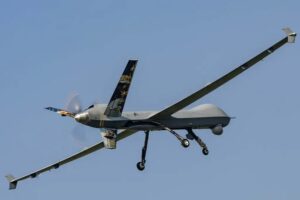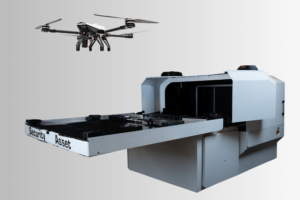Skydio, one of America’s most promising drone manufacturers, this week launched its Skydio Dock for the X10 drone. The news suggests increased emphasis on not just American-made drones, but drones that rely increasingly less on humans.
Skydio’s X10 Dock is designed for scalability and emphasizes autonomy. The company is marketing particularly for use by first responders. Though its products have high potential in all sorts of enterprise operations.
This week’s big product launch for Skydio comes in the wake of mounting political pressure in the U.S. to ban DJI drones. DJI drones dominate the global market but face concerns over security risks due to their Chinese origins. All that may represent a pivotal moment in reshaping the domestic drone industry.

Here’s what you need to know about the new Skydio X10 Dock. Plus, here’s our take on why it could be a promising piece of hardware in the landscape of American-made drones.
Skydio X10 Dock: everything you need to know
Skydio X10 Dock: How we got here
Skydio, founded in 2014, has always prioritized autonomy. That was evident even way back in 2018 when Skydio touted its Skydio R1 drone, a consumer-oriented drone that had sensors on all sides to make it a truly autonomous, follow-me drone.

Since then, tech improved, as evidenced by its new-and-improved Skydio 2 consumer drone. Ultimately, though, Skydio killed its consumer drone unit to instead focus entirely on growing its enterprise drone operations. And growing it is.
After seeing success with its Skydio X10 enterprise drone, the California-based drone maker has been riding the wave of interest in truly scalable drones that reduce or remove the need for skilled operators to control them. The Skydio X10 Dock allows drones to function without direct human oversight. Station them in strategic locations, and drones are ready for deployment at a moment’s notice.

This is not the first dock from Skydio. In December 2022, the company launched Skydio Dock, Skydio Dock Lite, and Skydio Remote Ops. That series of drone docks earned a nomination for AUVSI’s XCELLENCE in Innovation as part of the group’s sixth annual 2023 AUVSI XCELLENCE Awards.
What is the Skydio X10 Dock?
As is the case with any sort of drone dock, the Skydio Dock is a weather-resistant hub that houses — in this case — the X10 drone. Designed for industries including public safety and critical infrastructure, it incorporates advanced onboard AI, real-time data capture capabilities, and remote deployment. Through all that, the X10 can handle complex missions like continuous infrastructure monitoring, emergency response, and site security.
For first responders, the potential impact could be immense. The Skydio Dock allows deployment of drones in under 20 seconds. With that, drones can monitor scenes and provide information even before ground teams arrive. This type of deployment could significantly increase efficiency, safety and effectiveness for agencies tasked with public safety.

How the Skydio X10 Dock works
The Dock for X10 allows multiple drones to be stationed and managed remotely. That enables a scalable system that doesn’t require an operator on-site. These drones can run scheduled missions, such as inspecting electrical substations, surveying construction sites, or patrolling military bases. All the while, theyu’re autonomously capturing data at any time.
Of course, the dock only works with the actual Skydio drone, which has a robust visual navigation system given all the sensors. To land at the right spot on the dock, the Skydio X10 drone uses what’s called a visual fiducial system. With that, it can recognize the landing surface, orient itself into position, then land on the platform. Upon the drone’s landing, the Dock then seals up to protect and charge X10.
Together, the dock and drone make for a powerful duo. For example, Skydio Autonomy onboard the X10 enables the drone to fly without crashing into obstacles – day or night. Throw in the Dock, and now just one operator can command multiple (and — as Skydio suggests — even hundreds of) drones at one time.
Here are some situations where that use case is, well, useful:
- Pre-positioning drones in a city means public safety agencies can have eyes on scene during an emergency within seconds.
- Placing docked drones at an electrical substation enables continuous inspection of equipment and rapid response after natural disasters.
- A drone housed at a construction site monitors progress quality daily, while drones docked at large gathering venues can provide valuable real-time safety information.
- Docks and drones on military bases enable round-the-clock patrols for greater security.
Skydio X10 Dock specs

Here are some key features of the new Dock for X10:
- Can handle winds up to at least 160 mph winds.
- Built-in HVAC maintains a safe operating temperature for the drone in -4℉ to 122℉
- Dock is waterproof
- Flight operates from dock are possible in moderate rain and winds up to 28 mph during the day or night.
- Built for flight beyond visual line of sight (BVLOS).
- System features attached weather sensors, an ADS-B In receiver and inputs for radar systems
- Cameras embedded in the Dock allow for pre-flight checks
- Qualcomm SoC enables better image quality for the cameras and advanced AI compute
- Processing power of up to 100 Trillion Operations Per Second (TOPs)
A focus on drones for first response (DFR)
Though Skydio claims all sorts of enterprise customers, it’s put first responders at the forefront — as has long been the case.
Upon launching its initial dock back in December 2022, its early access partners including the North Carolina Department of Transportation (NCDOT) and California Department of Transportation (Caltrans). And in fact, Skydio says it has worked closely with more than 500 public safety agencies over the past five years.
Skydio said its proprietary simulation algorithm has helped agencies choose the best locations for their docks. That in turn sets them up to respond to more than 90% of high-priority calls for service within 2 minutes.
Skydio relies on DFR Command software

Alongside the launch of the Skydio X10 Dock comes Remote Ops, which is the software that fuels the operation of Dock for X10.
With it, you can fly on-demand from any remote location over a web browser. It uses a flight interface called Remote Flight Deck, which gives operators the choice of keyboard or game controllers as inputs to navigate. With the live stream, anyone who you want to view the drone footage can see it via secure, shareable ReadyLink URLs, with no login required.
Of course, the software has use cases that extend beyond just DFR systems. For example, the software’s Mission Planner function enables users to capture repetitive data sets over time which could be useful for situations like monitoring environmental landscape changes. Meanwhile, Skydio’s Visual Positioning System maps environments in real-time for precise data capture both inside and outside.
And should you want to map out your own route, you can create GPS missions by dragging and dropping waypoints around a map to create a custom flight path which you can then schedule to run on specific dates or at specific times.
That software has neat features such as a Transparency Dashboard. With it, agencies can (at their discretion) share flight details such as date, start/stop time, telemetry, reason for flight and case number.
Access points improve range
Having both a strong connection — and being able to fly long distances on such a strong connection — is critical with enterprise drones. To address that, Skydio uses what are called Connect Access Points. These external point-to-point radio modules designed for its X10 drone can be mounted at various vantage points along the route, but away from the Dock. In short, these offer more range and coverage for your drone flight.
These Access Points can be connected directly to the new Skydio X10 Dock (each dock comes standard with a Connect Access Point). Or, they can be deployed standalone with a direct internet connection. That means your drone is still connected, even if cellular coverage is not available.
If you do purchase a dock, Skydio says its own technicians will work with you to choose the best installation location based on your mission needs and local topography.
Other connection options including ethernet to your local network, a dedicated 5G connection using a Cradlepoint module and even Starlink (that’s the satellite internet constellation affiliated with SpaceX).
The U.S. drone market (and Skydio’s role in a shifting landscape)

Skydio’s launch of the X10 Dock comes amid increasing scrutiny of Chinese drone maker DJI. While DJI as an estimated 70% to 80% market share of the global commercial drone market, some U.S. politicians have called to ban DJI’s products. Some have drawn the line at simply banning the use of DJI drones for government operations. Others want to ban DJI drones in the U.S. entirely, arguing that drones produced by foreign companies may pose risks to national security, given concerns about data privacy and the potential for espionage.
As a result, U.S. companies such as Skydio (as well as others like Teal) are gaining ground. Products like the Skydio X10 dock make them even better positioned to capitalize on this moment.
And as the U.S. government continues to tighten restrictions on foreign-made drones, companies like Skydio will likely see increased demand from both public and private sectors for products like the X10 Dock. The potential to replace DJI’s stronghold in the U.S. drone market is now more tangible than ever with its dock launch. With pressure mounting to ban foreign drones, Skydio’s homegrown solution not only offers an alternative — but it signals the future direction of the American drone industry.
The post Can the Skydio X10 Dock reshape the American drone landscape? appeared first on The Drone Girl.





